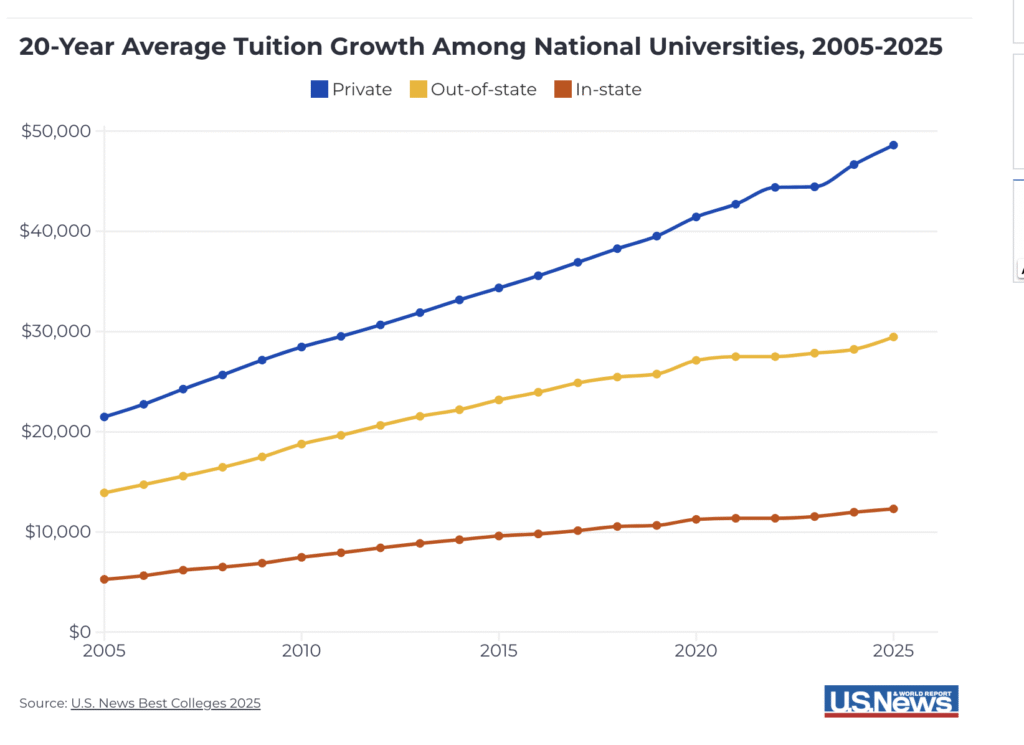
Think of a string quartet: it still takes four people the same time to play a piece as it did centuries ago. But their wages rise to match other jobs, making concerts pricier. The same thing happens with music lessons. The teacher’s time is limited, just like a craftsman’s. They can only teach so many students, which keeps costs high, unlike mass-produced goods. This is great way to understand the rising cost of higher education.

The Paradox of Rising Costs
Baumol’s Cost Disease describes a phenomenon where the cost of services in certain sectors, like education, healthcare, and the arts, rises over time despite no corresponding increase in productivity. This occurs because these sectors are labor-intensive, meaning they rely heavily on human capital. Unlike manufacturing or technology, where productivity can be significantly boosted through automation and innovation, the output of labor-intensive services often remains relatively constant.
In the case of higher education, the core service provided – the transfer of knowledge and skills from faculty to students – hasn’t changed dramatically over centuries. A professor in the 18th century taught a classroom of students using a chalkboard and lectures, not much different from how many professors teach today. However, the cost of attending college has skyrocketed due to rising faculty salaries and other expenses.
The Role of Wages and Productivity
Baumol’s theory suggests that as wages rise across the economy to keep pace with productivity gains in other sectors, wages in labor-intensive industries must also increase to attract and retain qualified workers. This leads to rising costs for consumers without a corresponding increase in the quality or quantity of the service provided.
In higher education, this translates to higher tuition costs as universities compete for top faculty and staff. While there are some efforts to increase efficiency through online learning and other technologies, the core value proposition of a college education – the personal interaction between students and professors – remains largely unchanged.

Baumol’s Cost Disease has several significant implications for higher education:
- Rising Tuition Costs: As the cost of providing higher education increases, tuition rates inevitably rise, making it more difficult for students to afford a college degree.
- Increased Student Debt: The rising cost of tuition has led to a significant increase in student debt, which can have long-term financial consequences for graduates.
- Reduced Access to Higher Education: The high cost of college can create barriers to access for low-income and first-generation students, limiting their opportunities for upward mobility.
- Potential for Innovation: While Baumol’s Cost Disease highlights the challenges facing higher education, it also presents opportunities for innovation. Institutions can explore new delivery models, leverage technology to increase efficiency, and find ways to reduce costs without compromising the quality of education.

Addressing the Costs
Several strategies can be employed to mitigate the effects of rising costs of higher education:
- Increased Efficiency: Institutions can use technology and other innovations to streamline operations and reduce costs.
- Tuition Alternatives: Exploring alternative funding models, such as income-based repayment or free tuition for low-income students, can help make college more accessible.
- Public-Private Partnerships: Collaborating with businesses and other organizations can help develop innovative solutions to the cost challenges facing higher education.
Labor intensive costs
By recognizing the inherent limitations of labor-intensive services, institutions can develop strategies to mitigate the effects of this phenomenon and ensure that higher education remains accessible and affordable for all students.
There are critics of this theory. Read a counter view point https://www.insidehighered.com/blogs/technology-and-learning/baumol-cost-disease-orthodoxy


